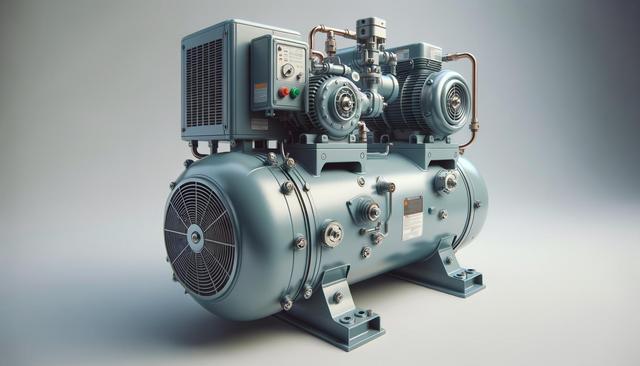What Is a Two-Stage Industrial Air Compressor?
A two-stage industrial air compressor is designed to compress air in two stages, resulting in higher efficiency and improved performance compared to single-stage models. In the first stage, ambient air is drawn in and compressed to an intermediate pressure, then cooled before entering the second stage where it is compressed again to the final pressure. This process reduces heat and wear, leading to longer equipment life and more efficient energy use. These compressors are typically used in manufacturing, automotive, construction, and other industrial environments where high-pressure air is essential for operations.
Two-stage compressors are often favored for their ability to deliver higher pressures—usually above 100 PSI—making them suitable for powering tools and machinery that require consistent airflow. The dual-stage mechanism also reduces the workload on each piston, which minimizes stress and promotes smoother operation. Additionally, the interstage cooling between the two compression phases helps maintain air quality and further improves the overall effectiveness of the system.
Key Advantages for Industrial Applications
Two-stage industrial air compressors offer several benefits that make them suitable for heavy-duty use. These advantages are particularly relevant in sectors where durability, efficiency, and reliability are non-negotiable. Some of the most notable benefits include:
- Greater efficiency due to reduced heat generation during compression
- Higher pressure output, ideal for demanding tools and equipment
- Longer lifespan as a result of balanced workload across multiple stages
- Lower energy consumption compared to single-stage models at similar outputs
Industries using these compressors often experience improved productivity because the machines can run for longer periods without overheating. They’re also better suited for continuous operation, which is crucial in facilities that operate around the clock. Furthermore, thanks to the interstage cooling, the final compressed air is of higher quality, which is beneficial in applications where moisture and contaminants can be problematic.
Common Use Cases in Industry
Two-stage industrial air compressors are widely used across various industries, each with unique requirements that benefit from the robust features of these machines. Some common applications include:
- Automotive repair and manufacturing
- Food and beverage processing
- Pharmaceutical production
- Construction and heavy equipment operations
- Textile and garment manufacturing
In automotive shops, for example, compressed air is necessary for tasks such as spray painting, running pneumatic tools, and tire inflation. In food processing, clean and dry compressed air is vital to ensure hygiene and compliance with safety standards. The versatility of two-stage compressors makes them a practical choice for businesses with varying operational needs.
Maintenance and Operational Considerations
Like any industrial equipment, two-stage air compressors require regular maintenance to ensure optimal performance and longevity. Preventive care not only extends the life of the compressor but also minimizes downtime and repair costs. Key maintenance practices include:
- Regularly checking and replacing air filters
- Monitoring oil levels and changing oil as recommended
- Inspecting belts and pulleys for wear
- Draining moisture from the air receiver tank
- Cleaning intercoolers and checking for leaks
Operators should also follow manufacturer guidelines and keep detailed maintenance records. Scheduling routine inspections can help identify potential issues before they escalate into costly repairs. Additionally, using high-quality parts and lubricants can significantly enhance the performance and reliability of the compressor over time.
Factors to Consider Before Investing
Before selecting a two-stage industrial air compressor, it’s important to evaluate your specific operational needs. Different models vary in terms of horsepower, tank size, and airflow capacity, so understanding your requirements will help you choose the most suitable unit. Key factors to consider include:
- Required PSI and CFM for your tools and equipment
- Frequency and duration of use
- Available space for installation and operation
- Energy efficiency and operational cost
- Noise level and ventilation requirements
Consulting with a professional or supplier can provide valuable insight into the right configuration for your facility. While initial investment costs may be higher for a two-stage compressor compared to a single-stage, the long-term benefits in efficiency, durability, and performance often justify the expense for industrial users.
Conclusion: A Smart Choice for High-Demand Operations
For businesses that rely on steady, high-pressure air supply, two-stage industrial air compressors offer a powerful and efficient solution. Their ability to handle continuous workloads, deliver consistent performance, and extend equipment life makes them a valuable asset in a variety of industrial settings. By understanding how these systems work and what to consider before purchasing, facility managers and operators can make informed decisions that support productivity and cost-efficiency.







